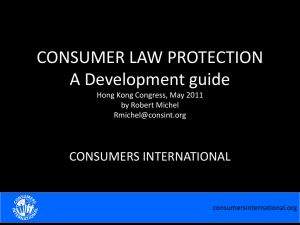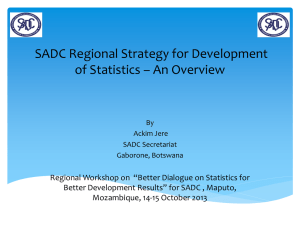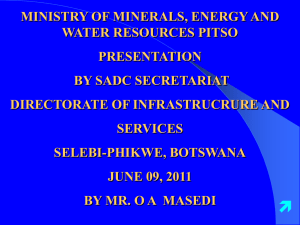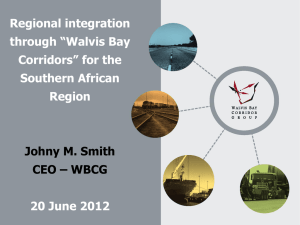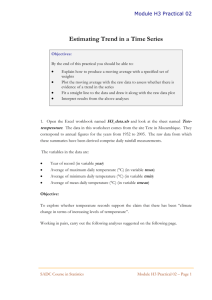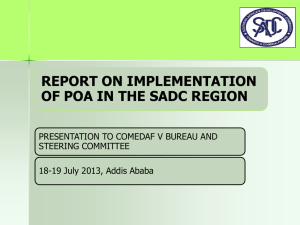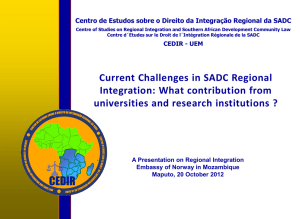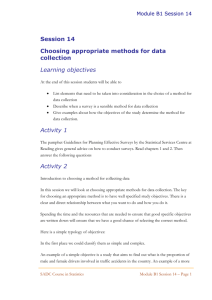policies achieving
advertisement
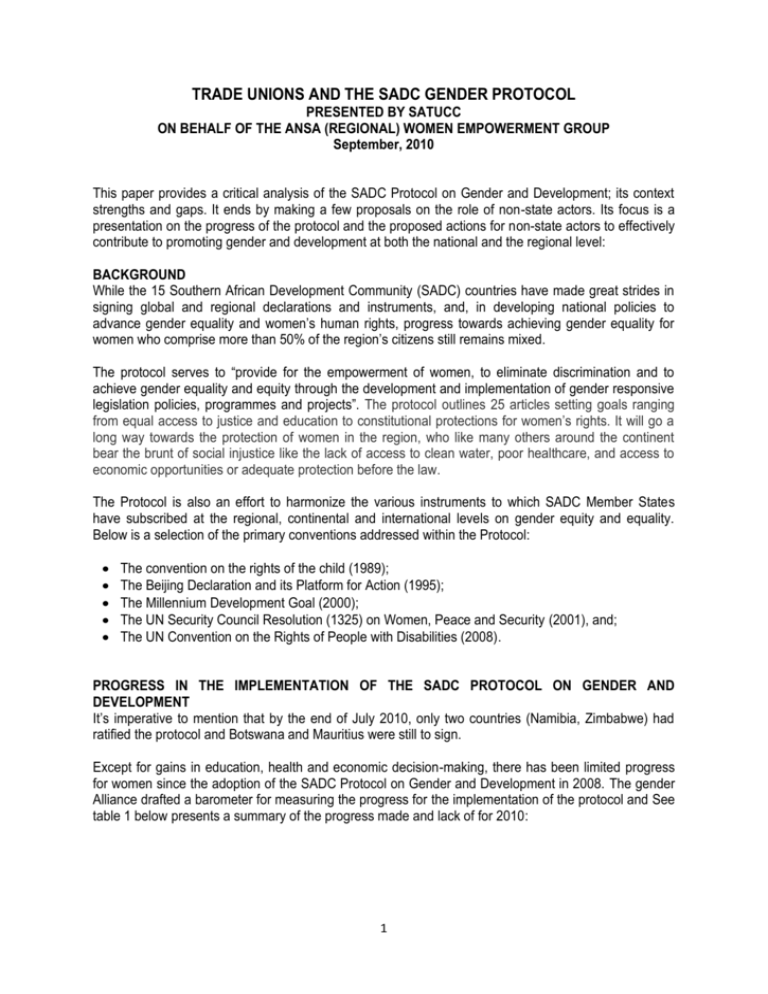
TRADE UNIONS AND THE SADC GENDER PROTOCOL PRESENTED BY SATUCC ON BEHALF OF THE ANSA (REGIONAL) WOMEN EMPOWERMENT GROUP September, 2010 This paper provides a critical analysis of the SADC Protocol on Gender and Development; its context strengths and gaps. It ends by making a few proposals on the role of non-state actors. Its focus is a presentation on the progress of the protocol and the proposed actions for non-state actors to effectively contribute to promoting gender and development at both the national and the regional level: BACKGROUND While the 15 Southern African Development Community (SADC) countries have made great strides in signing global and regional declarations and instruments, and, in developing national policies to advance gender equality and women’s human rights, progress towards achieving gender equality for women who comprise more than 50% of the region’s citizens still remains mixed. The protocol serves to “provide for the empowerment of women, to eliminate discrimination and to achieve gender equality and equity through the development and implementation of gender responsive legislation policies, programmes and projects”. The protocol outlines 25 articles setting goals ranging from equal access to justice and education to constitutional protections for women’s rights. It will go a long way towards the protection of women in the region, who like many others around the continent bear the brunt of social injustice like the lack of access to clean water, poor healthcare, and access to economic opportunities or adequate protection before the law. The Protocol is also an effort to harmonize the various instruments to which SADC Member States have subscribed at the regional, continental and international levels on gender equity and equality. Below is a selection of the primary conventions addressed within the Protocol: The convention on the rights of the child (1989); The Beijing Declaration and its Platform for Action (1995); The Millennium Development Goal (2000); The UN Security Council Resolution (1325) on Women, Peace and Security (2001), and; The UN Convention on the Rights of People with Disabilities (2008). PROGRESS IN THE IMPLEMENTATION OF THE SADC PROTOCOL ON GENDER AND DEVELOPMENT It’s imperative to mention that by the end of July 2010, only two countries (Namibia, Zimbabwe) had ratified the protocol and Botswana and Mauritius were still to sign. Except for gains in education, health and economic decision-making, there has been limited progress for women since the adoption of the SADC Protocol on Gender and Development in 2008. The gender Alliance drafted a barometer for measuring the progress for the implementation of the protocol and See table 1 below presents a summary of the progress made and lack of for 2010: 1 TABLE 1: KEY INDICATORS OF THE STATUS OF WOMEN IN SADC COUNTRIES Zimbabwe Zambia Tanzania Swaziland South Africa Seychelles Namibia Mozambique Mauritius Malawi Madagascar Lesotho DRC GOVERNANCE Parliament Local government Cabinet EDUCATION Primary school Secondary school Tertiary level ECONOMY Economic decision-making Income SEXUAL AND REPRODUCTIVE HEALTH Using contraception Births attended by skilled personnel HIV and AIDS Comprehensive knowledge on HIV and AIDS Living with HIV as proportion of total HIV positive pregnant women receiving PMTCT MEDIA Overall Board of Directors Senior Management Top Management Female staff in institutions of higher learning Proportion of students in institutions of higher learning News sources Botswana Angola % of Women 38.6 na 25.7 7.9 19.3 21.1 7.7 na 14.3 22.9 58 31.6 10.3 6 15.4 21.2 n/a 22.7 18.8 6.4 12 39.2 35.6 32.1 26.9 41.8 18.2 23.5 n/a 16.7 42.7 39.7 41.2 21.9 17.9 23.5 30.7 34.2 20 15.2 6.6 13 17.9 18.5 17.1 46 44 40 49 52 53 45 36 26 51 56 44 49 48 49 50 44 39 49 52 54 47 44 38 51 54 56 51 51 57 49 52 53 48 50 50 50 44 32 49 45 53 49 48 n/a 24 na 44 38 14 na 21 28 16 na 18 41 0 27 25 41 25 28 31 na 23 31 40 28 21 na 23 34 23 37 6 46 44 99 31 61 37 55 15 51 42 54 76 100 17 48 55 81 41 100 65 92 43 74 41 46 30 47 60 69 7 61 14 40 58 95 15 58 4 26 58 71 19 58 1.8 42 58 14 68 19 68.3 43 60 28 65 50 58 67 42 99 27 59 83 52 57 69 45 55 68 34 57 60.9 44 60 42.6 na na na na na na 46 24 39 30 37 54 73 47 50 56 18 77 22 18 8 18 67 73 33 10 20 13 44 71 23 27 26 19 29 50 33 36 22 25 79 82 27 25 35 17 28 26 40 39 35 42 47 60 na na na na na na 50 38 35 25 50 64 40 30 29 33 33 37 36 22 30 21 28 60 33 27 33 11 29 61 13 38 10 13 25 57 na 20 19 32 23 20 19 14 20 31 20 19 21 14 16 Source: Gender Barometer 2010: I. na=not available: n/a= not applicable; II. The % of women’s income is arrived at by adding male and female income for each country as determined by the ILO and then expressing female income as a % of the total. III. Figures in red, are those in which women constitute 50% or more of a particular indicator IV. 2 MAIN PROVISIONS TABLE 2: SADC GENDER PROTOCOL 2010 BAROMETER CITIZEN SCORE CARD SPECIFIC TARGETS TO PROGRESS DATA 2010 INDICATORS GOING FORWARD BE ACHIEVED BY 2015 ARTICLES 4-11: CONSTITUTIONAL AND LEGAL RIGHTS Provides for all Constitutions in the region to 1. Endeavour to enshrine gender enshrine gender equality and to give such equality and equity in their provisions primacy over customary law. All laws constitutions and ensure that that are discriminatory to women are to be these are not compromised by repealed. It also provides for equality in any provisions, laws or accessing justice, marriage and family rights of practices widows, elderly women, the girl, women with 2. Review, amended and or repeal disabilities and other socially exclude groups. all discriminatory laws. 3. Abolish the minority status of women SCORE OUT OF TEN 2009 2010 Most SADC Constitutions have non-discrimination clauses and 12 provide for nondiscrimination based on sex. 9 provide for gender equality. 6 Constitutions have claw back clauses only two Constitutions address contradictions between customary and customary practices that undermine women’s rights increase in the number of countries that include sex as a grounds for discrimination increase the number of countries that include gender equality in the Constitutions number of counties that ensure that Constitutional provisions are not undermined by any other law or practice 6 0 in each country there is discriminatory legislation to review Number of countries that review and eliminate all discriminatory practices. Number of countries that specifically abolish the minority status of women, and ensure that this is not undermined by customary law. 6 6 6 6 Very few countries have specific legislation to do so (e.g. Zimbabwe (legal age of Majority Act 1982) and Namibia (Married person Act). These laws are in any case undermined by customary law. ARTICLES 12-13: GOVERNANCE (REPRESENTATION AND PARTICIPATION) Provides for all equal representation of women in all areas of decision making, both public and private and suggests that this target be achieved through constitutional ad other legislative provisions, including affirmative action. It further stipulates that Member States should adopt specific legislative measures and other strategies, policies and programmes to ensure that women participate effectively n electoral processes and decision-making by, amongst others, building capacity, providing support and establishing and strengthening structures to enhance gender mainstreaming. 4. Endeavour to ensure that 50% of decision making positions in all public and private sectors are held by women including through the use of affirmative action measures. Parliament: The average representation of women in both houses across the region Number of countries that make a concerted effort and is 24%. This ranges from 7% in Botswana and 44% in South Africa. achieved gender parity in parliament. Local Government: The average representation of women at the local levels 29.7%. This ranges from 1.2% in Angola to 58% in Lesotho. Cabinet: The average representation of women in cabinet is up to 22% from 21.4% in 2009. It ranges from 41% in South Africa to 12% in Mauritius. President/ Prime Minister: There are no women Heads of States. Malawi and Zimbabwe have Deputy Presidents and Mozambique and Zimbabwe have a Woman Prime Minister and deputy Prime Minister respectively). Public Service: Comprehensive data is not available. For 8 countries for which data was available, this ranged from close to parity in Botswana to less than one –fifth in Malawi. Private sector & other areas of decision making: Comprehensive data not available. Affirmative action has been applied in many of the Members States (e.g. South Africa (Voluntary party quota; Employment Equity Act); Namibia (legislated and voluntary at local level), Mozambique and Angola (Voluntary party quota), Lesotho (local government electoral law). 5 5 5. Enact laws that promote equal aces to and retention in primary, secondary, tertiary, vocational and non-formal education in accordance e with the Protocol on Education & Training and the MDGs. Primary: Equal enrolment of girls and boys in all countries except Angola and DRC where girl constitute 46% of total enrolment. Secondary: Gender gaps are narrowing in all countries, more girls than boys in Lesotho, but girls only 36% in the DRC and 44% in Tanzania, Mozambique, Malawi and Angola. Tertiary: equal proportions of women in Swaziland, In Seychelles (58%) Namibia, Mauritius, South Africa, Botswana and Zambia there are more women than men. In Madagascar, Lesotho, Angola, Malawi, Mozambique, Tanzania and DRC, women are less than men (26% in the DRC is the lowest). The proportion of women in the teaching service ranges from 70% in Lesotho to 20% in the DRC; men pre-dominate as principal, women pre-dominate in the Arts and men in the Sciences and technical subjects; while there have been some reviews of curriculum gender stereotypes abound. GBV in schools is high Number of countries that attain gender parity at all levels of education. 7 7 Progress towards achieving gender parity in school administrations. Progress towards achieving gender parity in subjects. Changes to school curriculum. 6 6 ARTICLE 14: EDUCATION AND TRAINING It provides for equal access to quality education & training for women and men as well their retention at all levels of education. It further provides for challenging stereotypes in education and eradicating gender based violence in educational institutions. 6. Adopt and implement gender sensitive educational policies and programmes addressing gender stereotypes in education and gender based violence. 3 MAIN PROVISIONS SPECIFIC TARGETS TO BE ACHIEVED BY 2015 SCORE OUT OF TEN 2009 2010 PROGRESS DATA 2010 INDICATORS GOING FORWARD Women comprise 25% of decision makers designated as: Minister/ deputy Minister/ permanent Secretary of finance economic permanent sectary/ DG; governor, and deputy governor of the reserve bank. This ranges from Swaziland (40%) to Mauritius (none). Only South Africa, Malawi and Madagascar have conducted such studies; little evidence of policy measures flowing from these. Ad hoc initiatives mostly focus on micro-finance, e.g. in Mauritius the National women Entrepreneurship Council; Tanzania the National Micro-finance policy gives guidelines on achieving gender equality; SA provides various funds for micro-finance. Zimbabwe through the DPM’s office recently developed a national strategic plan for women empowerment. Most policies ate gender blind with very few exceptions e.g. Zambia Trade and Industrial policy recognises that women remain marginalised in the professional work place and private enterprise; proposes steps for addressing this. Only Southern Africa had a Preferential Public Procurement Act that provides for redressing historical imbalances including gender. The Mauritius Public procurement Act refers to “community and end user participation: without specifically referring to women. Comprehensive information is difficult to access; data obtained shows a range from 11% land ownership in Seychelles to 25% in DRC and Tanzania. In Botswana women are 46% in Landowners but holdings are smaller. IN Tanzania, women are about a third the size of those of men. Women earn on average 50% of men’s earnings in the SADC region. Number of counties that achieved gender parity in economic decision making. 4 4 Number of countries that have done time use studies. 5 4 Number of countries that have policies and laws to promote women’s participation in economic decision making. 5 5 Number of countries that view trade and entrepreneurship policies from a gender perspective. 4 4 Number of public procurement acts and procedures that socially mention gender equality. 5 5 Number of countries that review laws and extent to which these promote parity in ownership. 5 5 Number of countries that have ratified that ILO conventions and conventions 100 and 101. Completed audit of current labour legislation. 6 6 9 SADC countries have legislation on domestic violence; only 7 have specific legislation that relates to sexual offences. 3 countries have no specific legislationAngola, Madagascar and Zambia. Only SA has included the provision of comprehensive treatment and care, including PEP to survivors and sexual assault. In Botswana, Mauritius, Namibia, Zambia this is included in policies but not law this less enforceable. Seychelles provides for health workers only. PEP in most countries is not well accessed. 12 SADC countries have signed the UN protocol to prevent, suppress & punish human trafficking, especially women and children (Palermo Protocol). 6 have specific laws on human trafficking (Madagascar, Mauritius, Mozambique, Swaziland, Tanzania and Zambia) - an increase from4 last year. In SA and Zimbabwe trafficking is provided for in Sexual Offenses legislation. Malawi is receiving support from IOM to develop legislation. Only 5 countries (Lesotho, Namibia, SA, Tanzania, and Zimbabwe) have sexual offences legislation. Number of specific GBV laws per country, measure changes in laws periodically. 6 5 Number of laws that have clauses that provide for comprehensive testing, treatment and care. 6 6 Number of countries with sexual offences acts. 6 6 Number of countries with specific legislative provisions to prevent human trafficking and provide politics services. Number of people reintegrated into society. Number of cases that have been prosecuted for those that have laws) Number of new countries that adopt legislation or add human trafficking provisions to their legislation 5 5 10 SADC countries have legislation for sexual harassment mostly in labour laws. e.g. Botswana, Mozambique, Namibia, South Africa & Zimbabwe). In Tanzania it’s covered in the Penal Code and Sexual Offences Act. Number of countries with sexual harassment legislation, polices and strategies. 5 5 ARTICLES 15-19: PRODUCTIVE RESOURCES AND EMPLOYMENT, ECONOMIC EMPOWERMENT This article provides for the equal 7. participation of women in economic policy formulation and implementation. The article has provisions and targets on 8. entrepreneurship, access to credit and public procurement contracts, as 9. well as stipulations on trade policies, equal access to property, resources and employment. Ensure equal participation by women and men in policy formulation and implementation of economic policies. Conduct time use studies and adopt policy measures to erase the burden of the multiple roles played by women Adopt policies and enact laws which ensure equal access, benefits, and opportunities for women and men in trade and entrepreneurship, taking into account the contribution of women in the formal and informal economy/ sectors. 10. Review national trade and entrepreneurship polices to make them gender responsive. 11. With regard to the affirmative action provisions of Article 5, introduce measures to ensure that women benefit equally from economic opportunities, including through public procurement processes. 12. Review all policies and laws that determine access to control of and benefit from, productive resources by women. 13. Review, amend and enact laws and policies that ensure women and men have equal access to wage employment in all sectors of the economy. ARTICLES 20-25: GENDER BASED VIOLENCE It makes provision for all the 14. Enact and enforce legislation prohibiting all forms of implementation of a variety of GBV. strategies, including enacting, reviewing, reforming and enforcing 15. Ensure that laws on GBV provide for the comprehensive laws, aimed at eliminating all forms of testing, treatment and care for survivors of sexual gender based violence and assault. trafficking. There are specific stipulations for the provision of a 16. Review and reform their criminal laws and procedures comprehensive package of treatment applicable to cased of sexual offence and BGV. and care services for survivors of GBV, including the access to post exposure prophylaxis and the establishment of special courts to address these cases. There are 17. Enact and adapt specific; legislative provisions to specific provisions for human prevent human trafficking amend provide holistic trafficking. A section which provides services to the victims, with the aim of re-integrating for monitoring and evaluation set them into society. targets and indicators for reducing GBV levels by half in 2015. 18. Enact legislative provisions and adopt and implement policies, strategies and programmes which define and prohibit sexual harassment in all spheres and provide deterrent sanctions for perpetrators of sexual harassment. 4 19. Adopt integrated approaches, including institutional cross sector structures, with the aim of reducing current levels of GBV by half by 2015. MAIN PROVISIONS SPECIFIC TARGETS TO BE ACHIEVED BY 2015 14 SADC countries have adopted and implementing national action plans/ strategies/ response to end GBV. Many are moving away from 16 to 365 day action plans to end GBV. However, plans lack specific targets and indicators, effective M&E. Data on GBV is sporadic and unreliable. Pilot to develop GBV indicators in SA Mauritius & Botswana. All countries to develop country specific National Action Plans Effectiveness of NAPS as measured as measured by countries that have already adopted GBV NAPs Extent of GBV, and reduction each year as measured through the GBV indicators study. 6 6 SCORE OUT OF TEN 2009 2010 PROGRESS DATA 2010 INDICATORS GOING FORWARD In 2001/2 on SA and Zimbabwe fulfilled year commitment to allocate 15% of get expenditure to health. Lesotho, Mozambique & Swaziland achieved about half of the 15% target. Botswana achieved 10.5% Maternally mortality varies widely from 28 per 100,000 in Mauritius to 1140 per 100,000 in DRC. Only 3 Southern Africa countries have contraceptive usage rate of over 60%; SA is highest at 65% Zimbabwe was second, with 58%, Angola lowest at 5%. All SADC countries to have gender sensitive health policies that address issues of access and quality. 6 6 Number of countries especially those with high levels to achieve a 7% reduction in maternal mortality. % of people accessing and using contraceptives Gender disaggregated data according to types of contraceptives. Number of countries that achieve 100% sanitation coverage. 6 6 6 6 5 5 % reduction of HIV and AIDS in each country and reducti9on in the gender gap Increase in comprehensive knowledge on HIV and AIDS. Number of countries that achieves universal access for women & men & gender aggregated data to track progress. Development of a model policy/ checklist on care work Number of countries that meet the standards of the model policy 6 6 7 6 6 4 Extent to which gender parity consideration are taken into account in Madagascar and in all peace processes. 4.5 4 number of media houses that achieve gender parity at all levels Progress towards attaining gender parity in news sources. 4 4 ARTICLE 26: HEALTH This article provides for the adoption & implementation of polices& programmes that addresses the physical, mental, emotional and social well-being of women with specific targets for reducing maternal mortality ratio and ensuring access to quality sexual & reproductive health services. 20. Adopt & implement legislative framework, policies, programmes and services to enhance gender sensitive, appropriate & affordable health care. 21. Reduce the maternal mortality ratio by 75% 22. Develop and implement policies and programmes to address the mental, sexual and reproductive health needs of women and men. 23. Ensure the provision of hygiene and sanitary and nutritional needs of women, including women in prison. Total coverage of sanitation facilities varies from 100% is Seychelles, Mauritius to 15% in Madagascar, urban coverage is generally better than rural coverage. ARTICLES 27: HIV AND AIDS This article covers prevention, treatment, care and support relation to HIV and AIDS. 24. Develop gender sensitive strategies to prevent new infections. 4 of 15 countries have a prevalence of over 15%. With the exception of Mauritius and Seychelles women in SADC have a higher prevalence rate. 25. Ensure universal access to HIV and AIDS treatment for infected women, men boys and girls. 26. Develop and implemented policies & programme to ensure the appropriate recognition of work carried out by care-givers the majority of whom are women, the allocation of resources and psychological support for care-givers as well as promote the involvement of men in the care and support of people living with AIDS. Access to ARVs range from 3% in Madagascar to 95.2% in Seychelles. At least 9 countries score above 50% access. Poor disaggregated data by gender. A GEMSA audit study based on remuneration, logistic and material support, training and professional recognition, psychological support and gender consideration rated the policy of 1 SADC country (Namibia) as excellent, Botswana, Tanzania, Zimbabwe as good; Swaziland, South Africa as fair, Zambia and Malawi as mediocre; Lesotho, Mozambique, Mauritius and DRC as poor. ARTICLE 28: PEACE BUILDING AND CONFLICT RESOLUTION This provides for the equal representation of women in conflict resolution & peace building processes as well as the integration of a gender perspective in the resolution of conflict in the region. 27. Put in place measures to ensure that women have equal There are no special measures to ensure women’s representation ad representation and participation in key decision making participation in the sector. positions in conflict r5esoltuion and peace building With 24% women in defence force and 21% in the police forces, SA leads the processes, in accordance with UN Council resolution way. 1325 on Women, Peace and Security. ARTICLES 29-31: MEDIA, INFORMATION AND COMMUNICATION Provides for gender to be 28. Take measures to promote the equal representation of mainstreamed in all information, women in ownership of, and decision-making structures communication & media policies & of the media, in accordance with Article 12.1 that laws. It calls for women’s equal provides for equal representation of women in decisionrepresentation in areas of media making positions by 2015. work and for women and men to be given equal voice through the media. The protocol calls for increasing programmes of, by and about women and the challenging of gender stereotypes in the media. Media houses: The glass Ceiling in Southern African newsrooms study by GL found that women constitute 41% of media employees, 32% if South Africa is excluded. This ranges from 70% in Lesotho to 13% in Zimbabwe. Women constitute less than 25% of those on the board of governors, as top and senior managers in the media. Sources: the Gender and Media progress Studies (GMPS) showed that the proportion of women sources in the news had increased by a mere 2% to 19% since the baseline study concluded in 2003. 2009 total: 154/280 X100 = 55% OVERALL SCORE 5 2010 total: 152/280 X100 = 54.3% THE ROLE OF CIVIL SOCIETY This section of the paper only seeks to stimulate thoughts around possible actions that civil society organisations can undertake/ consider for pushing for the implementation of the SADC Gender and Development Protocol and on ensuring that our countries are creating a conducive socio-economic and political environment that promotes gender equality and poverty reduction, (the last thing we want is to ensure that men and women are equal in a poor and non-functioning economy!!): Action 1: Civil societies with direct influence within the SADC Secretariat Identification of civil society organisations that have been invited to input into the Heads of State Summit is important for collaborative efforts. This will provide other civil society organisations to organise and submit more comprehensive input representative of more civil society organisations/ institutions around gender and development issues, e.g. Gender Alliance, SADC-CNGO, SATUCC, and the CSO newly formed Apex Body etc: Action 2: Development of a regional civil society declaration on gender and developmentmaking the protocol a reality Declaration(s) can be formulated and signed by willing civil society organisations and submitted to the Senior Policy Officials assigned to work on Gender and Development portfolios within the SADC Secretariat. The following could be considered in the development of regional/ national declarations: Identifying priority areas within these very broad thematic areas (e.g. select the articles within the Gender and Development protocol which we think are more important in the short-term or those that we feel we have the comparative advantage to make the most impact); Listing targets and goals which are to be met by 2015 (within the framework of the protocol); Development of benchmarks- to measure impact of CSOs influence within the SADC Gender and Development protocol at both regional and national level around implementation. Action 3: Organise a campaign around the protocol There are many options that CSOs (or for us as FOS partners) can consider in beginning an active campaign around the protocol- going beyond the sixteen days of activism for this year-planned to begin on the 25th of November): Holding national and regional campaigns for civil society on: gender based violence (GBV), gender and poverty reduction and other relevant thematic areas such as: Regional Integration, Poverty reduction and Employment creation- around the 16 days of activism against. However, the objectives and targets have to be clearly spelt out and an action plan developed on how these campaigns will feedback into the SADC and national decision- making processes ; Holding other national campaign activities in the forms of meetings, workshops, mass mobilization campaigns, open debate and discussion forums, develop active blog sites within our websites around the relevant issues; Action 4: Information publication and distribution Targets can include: policy makers (both at the regional and national level), strategic partners (trade unions, church institutions, NGOs, CSOs) who may not be currently actively involved in the process, the general public at large. This can be done through the following mechanisms; Posting information on our websites; Developing and distributing brochures and papers on selected priority focus areas both at the regional and national level; Send copies of these papers/ declaration to the relevant ministries at the national level; Publication of relevant articles in all formats of media. 6 Action 5: Long-term activities Activities that can be considered for the long-term could include: Continued input and demand for effective participation in the SADC Secretariat decision making/ policy formulation frameworks on gender and development and poverty related thematic frameworks (e.g. the national and regional social observatories, national gender budgeting processes etc) Informative research and information distribution: there is very poor regional research related to: o gender disaggregated statistics, the care economy and its economic value and or contribution to growth and development, monitoring and evaluation of the implementation of the protocol in all participating countries; Capacity building of CSOs, NGOs, Trade Unions, Church institutional frameworks to effectively engage in the advocacy and engagement with policy makers on relevant issues related to gender and development; Monitoring and evaluation of the implementation of the protocol at national level; Take advantage of constitutional processes taking place in countries like Zimbabwe and advocate for the consitutionalisation to rectify the gaps in addressing gender issues. 7
